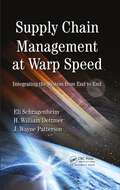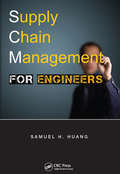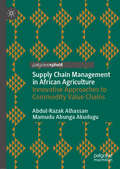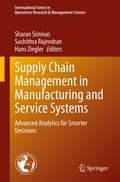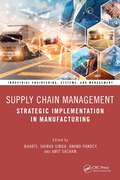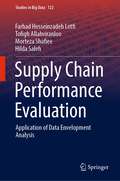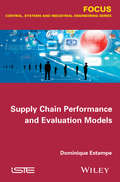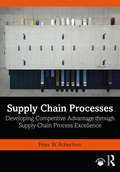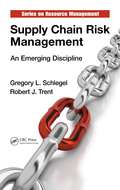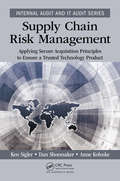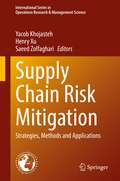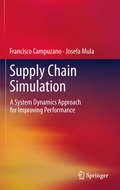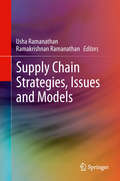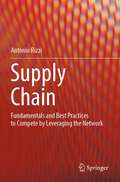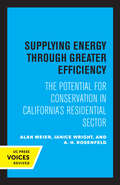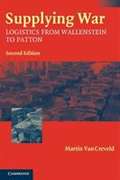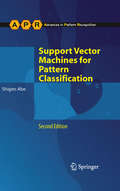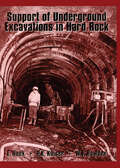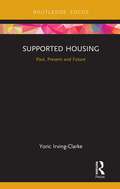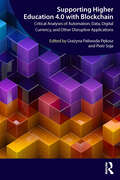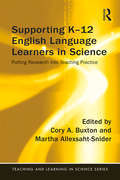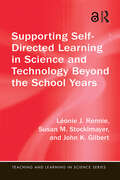- Table View
- List View
Supply Chain Management at Warp Speed: Integrating the System from End to End
by Eli Schragenheim H William Dettmer J. Wayne PattersonThis sequel to the bestselling Manufacturing at Warp Speed, refines and updates the former approach to production management. This is the first book to describe, in detail, the application of the TOC approach to assured availability in distribution, for both original equipment manufacturers and retailers. It addresses the new demands taken on when a firm offers to handle rush orders and addresses the issues surrounding availability, and the management of inventory as it moves through distribution systems.
Supply Chain Management for Engineers
by Samuel H. HuangOriginally taught mainly in business schools, supply chain management has become a common elective and graduate course in engineering colleges. The increasing demand for engineers with supply chain knowledge has fed this shift. However, supply chain management textbooks that have a reasonable coverage of quantitative analysis techniques are few and
Supply Chain Management in African Agriculture: Innovative Approaches to Commodity Value Chains
by Abdul-Razak Alhassan Mamudu Abunga AkuduguThis book examines supply and value chains in African agriculture, providing both a thorough analysis of existing practices and practical business models for future development. It examines why Africa is a net importer of food, despite its vast agricultural potential, using the tomato value chain in Ghana as a case study. The book explores commodity value chain structures; commodity clusters, arenas, linkages and business models; systematic constraints within commodity value chains; and value chain profiling in practice among others. It would benefit policy makers, policy implementers, development practitioners, agri-entrepreneurs, researchers and all those who have interests in the transformation of African agriculture. It will also be an excellent reference material for students of agriculture management, agribusiness, agricultural economics, and rural development.
Supply Chain Management in Manufacturing and Service Systems: Advanced Analytics for Smarter Decisions (International Series in Operations Research & Management Science #304)
by Hans Ziegler Sharan Srinivas Suchithra RajendranManagement of supply chains has been evolving rapidly over the last few years due to the inception of Industry 4.0, where businesses adopt automation technologies and data exchanges leading to dynamic and interconnected supply chain systems. Emphasizing on analytical approaches such as predictive and prescriptive modeling, this book presents state-of-the-art original research work dealing with advanced analytical models for the design, planning, and operation of the supply chain to provide faster and smarter decisions in the era of digitization. In particular, the book integrates machine learning and operations research models for faster and smarter decisions, presents prescriptive analytics models for strategic, tactical, and operational decision making in the supply chain, and addresses recent challenges such as sustainability in the supply chain, supply chain visibility, and supply chain digitalization. Key concepts are illustrated using real-life case studies, making the book a valuable reference for researchers, technical professionals, and students.
Supply Chain Management: Strategic Implementation in Manufacturing (Industrial Engineering, Systems, and Management)
by Anand Pandey Bharti Shikha Singh Amit SachanThe reference text discusses fundamental principles, planning, sourcing, demand forecasting, and supply forecasting in the field of supply chain management. It further highlights the important aspects of supply chain management such as resource planning, inventory management, quality tools, and documentation in logistics. It demonstrates the issues, barriers, emerging trends, and technological advances in supply chain management.This book: Discusses the principles of resource planning and inventory management in supply chain management Covers aspects of competing strategies and networking management Presents case studies highlighting ongoing practices and real-time issues in supply chain management Highlights the importance of demand and supply forecasting in the field of supply chain management Explains quality tools, emerging trends, challenges, and barriers in supply chain management It is written primarily for senior undergraduate and graduate students, and academic researchers in the fields of industrial engineering, production engineering, mechanical engineering, management, supply chain management, and manufacturing engineering.
Supply Chain Performance Evaluation: Application of Data Envelopment Analysis (Studies in Big Data #122)
by Tofigh Allahviranloo Farhad Hosseinzadeh Lotfi Morteza Shafiee Hilda SalehThe authors of this book tried to make these experiences available to those interested, considering the experience of several years of training, research, and implementation of projects in the supply chain performance evaluation field.This book intends to identify the current performance and competitive position of that supply chain compared to other supply chains by presenting and reviewing the techniques and models for measuring the efficiency and performance of the supply chain. Determining the performance of a supply chain is a good description of the status quo (what is). Determining the performance of a supply chain is useful for describing the past and present of supply chain processes, and on the other hand, it can be used to set performance goals and initiate the improvement process. To realize this, a strategic framework or model is needed to be able to extract indicators related to the efficiency of the supply chain and design the appropriate model.
Supply Chain Performance and Evaluation Models
by Dominique EstampeThis book presents the different models of supply chain performance evaluation for global supply chains. It describes why it is necessary to evaluate global performance both to assess the contribution of the supply chain to achieve the goals of creating value throughout the chain and also to meet customer requirements in terms of time, responsiveness and reliability. The author provides an understanding of how evaluation models are chosen according to criteria including the level of maturity of the organization, the level of decision-making and the level of value creation desired.
Supply Chain Processes: Developing Competitive Advantage through Supply Chain Process Excellence
by Peter W. RobertsonSupply Chain Processes introduces readers to the view that genuine supply chain competitive advantage is achieved via supply chain excellence which in turn is underpinned by supply chain process excellence. The ultimate supply chain goal is to deliver the right product, of the right quality, in the right quantity, to the right place, at the right time and for the right cost. The author identifies four core supply chain processes – strategy, design, execution and people – to which the process improvement techniques explained can be applied to ensure superior supply chain performance. Key topics are addressed, including supply chain risk, resilience, sustainability, challenges confronting modern-day supply chains and developing an elegant supply chain design. Each chapter starts with a section that explores learning opportunities and is followed by detailed chapter content. Carefully explained examples are provided, as well as end of chapter case studies, review questions and written assignments. A full suite of teaching aids is also provided for lecturers and tutors. Providing both management expertise and technical skills, which are essential to decision-makers in the supply chain, this textbook should be essential reading for undergraduate and post-graduate students, working people or mature aged persons wanting to upgrade their qualifications, and operating supply chain leaders and supply chain professionals. Online resources include chapter-by-chapter PowerPoint slides, tutorial exercises, written assignments and a test bank of exam questions.
Supply Chain Risk Management: An Emerging Discipline (Resource Management)
by Gregory L. Schlegel Robert J. TrentYou don�t have to outrun the bear � you just have to outrun the other guy. Often in business we only have to run a bit faster than our competitors to be successful. The same is true in risk management. While we would always like to anticipate and prevent risk from happening, when risk events do occur being faster, flexible, and more responsive than
Supply Chain Risk Management: Applying Secure Acquisition Principles to Ensure a Trusted Technology Product (Internal Audit and IT Audit)
by Dan Shoemaker Anne Kohnke Ken SiglerThe book presents the concepts of ICT supply chain risk management from the perspective of NIST IR 800-161. It covers how to create a verifiable audit-based control structure to ensure comprehensive security for acquired products. It explains how to establish systematic control over the supply chain and how to build auditable trust into the products and services acquired by the organization. It details a capability maturity development process that will install an increasingly competent process and an attendant set of activities and tasks within the technology acquisition process. It defines a complete and correct set of processes, activities, tasks and monitoring and reporting systems.
Supply Chain Risk Mitigation: Strategies, Methods and Applications (International Series in Operations Research & Management Science #332)
by Yacob Khojasteh Henry Xu Saeed ZolfaghariThis book covers central issues in mitigating supply chain risks from various perspectives. Today’s supply chains are vulnerable to disruptions that can have a significant impact on firms, business and performance. The aim of supply chain risk management is to identify the potential sources of risks and implement appropriate actions in order to mitigate supply chain disruptions. In this regard, the book presents a wealth of methods, strategies and analyses that are essential for mitigating supply chain risks. As a comprehensive collection of the latest research and cutting-edge developments in supply chain risk and its mitigation, the book is structured into four main parts, addressing supply chain risk strategies and developments; supply chain risk management review; supply chain sustainability and resilience; and supply chain analysis and risk management applications. The contributing authors are leading academic researchers and practitioners, who combine findings and research results with a practical and contemporary view on how companies can best manage supply chain risks and disruptions, as well as how to create resilient and sustainable supply chains. This book can be used as an essential resource for students and scholars who are interested in pursuing research or teaching courses on the rapidly growing field of supply chain management. It also offers an interesting and informative read for managers and practitioners who need to deepen their understanding of effective supply chain risk management.
Supply Chain Simulation
by Francisco Campuzano Josefa MulaSupply Chain Simulation allows readers to practice modeling and simulating a multi-level supply chain. The chapters are a combination of the practical and the theoretical, covering: knowledge of simulation methods and techniques,the conceptual framework of a typical supply chain,the main concepts of system dynamics, anda set of practice problems with their corresponding solutions.The problem set includes illustrations and graphs relating to the simulation results of the Vensim® program, the main code of which is also provided. The examples used are a valuable simulation tool that can be modified and extended according to user requirements. The objective of Supply Chain Simulation is to meet the demands of supply chain simulation or similar courses taught at the postgraduate level. The "what if" analysis recreates different simulation scenarios to improve the decision-making process in terms of supply chain performance, making the book useful not only for postgraduate students, but also for industrial practitioners.
Supply Chain Strategies, Issues and Models
by Usha Ramanathan Ramakrishnan RamanathanIn the 21st century, supply chain operations and relationships among supply chain partners have become highly challenging, necessitating new approaches, e. g. , the development of new models. Supply Chain Strategies, Issues and Models discusses supply chain issues and models with examples from actual industrial cases. Expert authors with a wide spectrum of knowledge working in various areas of supply chain management from various geographical locations offer refreshing, novel and insightful ideas and address possible solutions using established theories and models. Supply Chain Strategies, Issues and Models features studies that have used mathematical modeling, statistical analyses and also descriptive qualitative studies. The chapters cover many relevant themes related to supply chains and logistics including supply chain complexity, information sharing, quality (six sigma), electronic Kanbans, inventory models, scheduling, purchasing and contracts. To facilitate easy reading, the chapters that deal with supply chain related issues are first, followed by studies on inventory, scheduling, purchasing and logistics. This book can be used as a useful resource of supply chain management by academics, students and practitioners. This book can serve as a helping tool in managerial decision making for investments in collaboration and information exchange to improve forecasts, scheduling and inventory management, and for supply chain managers to leverage product and process complexities into competitive advantage. Some interesting mathematical models can appeal to students and researchers interested in modeling the impact of information sharing in supply chains.
Supply Chain: Fundamentals and Best Practices to Compete by Leveraging the Network
by Antonio RizziThe book examines the supply chain from different perspectives: the physical structure which it is composed of (actors, roles, infrastructures and processes), the organizational structure of the people involved (business functions and related interactions and integrations), and the manifold flows that characterize it (product flows, information flows, service flows and monetary flows). For each of these dimensions, the text thoroughly illustrates how to design and manage it, aligning supply chain performance and competitive strategies through an integrated approach, which is key to generate competitive advantage. The book covers the different topics by combining a quantitative approach typical of engineering disciplines and adopted particularly in the operational parts, with a qualitative approach which fits in the more strategic parts. This combination makes the volume suitable for both under- and post-graduate students in industrial engineering and management, as well as undergraduates or masters students confronting supply chain management from different cultural backgrounds. Industry operators and practitioners can also find useful insights, since it thoroughly describes industry best practices, especially in the food and consumer goods, fashion and apparel, pharmaceutical and healthcare sectors, stemming from author’s real life experiences in these fields.
Supplying Energy through Greater Efficiency: The Potential for Conservation in California's Residential Sector
by Alan Meier Janice Wright A. H. RosenfeldThis title is part of UC Press's Voices Revived program, which commemorates University of California Press’s mission to seek out and cultivate the brightest minds and give them voice, reach, and impact. Drawing on a backlist dating to 1893, Voices Revived makes high-quality, peer-reviewed scholarship accessible once again using print-on-demand technology. This title was originally published in 1983.
Supplying War: Logistics from Wallenstein to Patton
by Martin Van CreveldWhy did Napoleon succeed in 1805 but fail in 1812? Could the European half of World War II have been ended in 1944? These are only two of the many questions that form the subject-matter of this book. Drawing on a very wide range of sources, van Creveld examines the specifics of war: namely, those formidable problems of movement and supply, transportation and administration, so often mentioned - but rarely explored - by the vast majority of books on military history. In doing so he casts his net far and wide, from Gustavus Adolphus to Rommel, from Marlborough to Patton, subjecting the operations of each to a thorough analysis from an unusual point of view. In this edition with a new introduction, van Creveld revisits his now-classic text, and comments in a new afterword on the role of logistics in high-tech, modern warfare.
Supplying the Nuclear Arsenal: American Production Reactors, 1942-1992
by Rodney P. CarlisleOriginally published in 1996. Although the history of commercial-power nuclear reactors is well known, the story of the government reactors that produce weapons-grade plutonium and tritium has been shrouded in secrecy. Supplying the Nuclear Arsenal looks at the origin and development of these production reactors, Rodney Carlisle and Joan Zenzen describe a fifty-year government effort no less complex, expensive, and technologically demanding than the Polaris or Apollo programs—yet one about which most Americans know virtually nothing. Carlisle and Zenzen describe the evolution of the early reactors, the atomic weapons establishment that surrounded them, and the sometimes bitter struggles between business and political constituencies for their share of "nuclear pork." They show how, since the 1980s, aging production reactors have increased the risk of radioactive contamination of the atmosphere and water table. And they describe how the Department of Energy mounted a massive effort to find the right design for a new generation of reactors, only to abandon that effort with the end of the Cold War. Today, all American production reactors remain closed.Due to short half-life, the nation's supply of tritium, crucial to modern weapons, is rapidly dwindling. As countries like Iraq and North Korea threaten to join the nuclear club, the authors contend, the United States needs to revitalize tritium production capacity in order to maintain a viable nuclear deterrent. Meanwhile, as slowly decaying artifacts of the Cold War, the closed production reactors at Hanford, Washington, and Savannah River, South Carolina, loom ominously over the landscape.
Support Vector Machines for Pattern Classification
by Shigeo AbeA guide on the use of SVMs in pattern classification, including a rigorous performance comparison of classifiers and regressors. The book presents architectures for multiclass classification and function approximation problems, as well as evaluation criteria for classifiers and regressors. Features: Clarifies the characteristics of two-class SVMs; Discusses kernel methods for improving the generalization ability of neural networks and fuzzy systems; Contains ample illustrations and examples; Includes performance evaluation using publicly available data sets; Examines Mahalanobis kernels, empirical feature space, and the effect of model selection by cross-validation; Covers sparse SVMs, learning using privileged information, semi-supervised learning, multiple classifier systems, and multiple kernel learning; Explores incremental training based batch training and active-set training methods, and decomposition techniques for linear programming SVMs; Discusses variable selection for support vector regressors.
Support of Underground Excavations in Hard Rock
by E. Hoek P.K. Kaiser W.F. BawdenThe safe and economical construction of tunnels, mines, and other subterranean works depends on the correct choice of support systems to ensure that the excavations are stable. These support systems should be matched to the characterstics of the rock mass and the excavation techniques adopted. This expansive text explores the design of rockbolts, dowels, cable bolts and shortcrete for underground excavations in hard rock, and covers key topics including rock mass classification systems, and support design for overstressed rock.
Supported Housing: Past, Present and Future (Routledge Focus on Housing and Philosophy)
by Yoric Irving-ClarkeThis book covers the history of supported housing provision in the context of the broader political and theoretical considerations of the time in which the respective policies were being implemented. The book takes an historical perspective using path dependency as an analytical framework. Particular attention is paid to the critical junctures in the path of supported housing provision and how these limited and continue to limit the policy choices available. The book concludes with a look at the current state of supported housing policy with a view to making recommendations for how policy in this area could be carried forward. The hope is that readers of this book learn the lessons of previous policy initiatives in this area and, by looking at the philosophical underpinning for supported housing can make recommendations for how it can be funded and provided in the future. This book provides a valuable resource for scholars and practitioners seeking to both provide and influence policy in this area. It is also a useful source for students studying housing and urban policy.
Supported Layered Double Hydroxides as CO2 Adsorbents for Sorption-enhanced H2 Production
by Diana Iruretagoyena FerrerThis thesis presents a combination of material synthesis and characterization with process modeling. In it, the CO2 adsorption properties of hydrotalcites are enhanced through the production of novel supported hybrids (carbon nanotubes and graphene oxide) and the promotion with alkali metals. Hydrogen is regarded as a sustainable energy carrier, since the end users produce no carbon emissions. However, given that most of the hydrogen produced worldwide comes from fossil fuels, its potential as a carbon-free alternative depends on the ability to capture the carbon dioxide released during manufacture. Sorption-enhanced hydrogen production, in which CO2 is removed as it is formed, can make a major contribution to achieving this. The challenge is to find solid adsorbents with sufficient CO2 capacity that can work in the right temperature window over repeated adsorption-desorption cycles. The book presents a highly detailed characterization of the materials, together with an accurate measurement of their adsorption properties under dry conditions and in the presence of steam. It demonstrates that even small quantities of graphene oxide provide superior thermal stability to hydrotalcites due to their compatible layered structure, making them well suited as volume-efficient adsorbents for CO2. Lastly, it identifies suitable catalysts for the overall sorption-enhanced water gas shift process.
Supported Metal Single Atom Catalysis
by Philippe Serp Doan Pham Minh>Supported Metal Single Atom Catalysis Covers all key aspects of supported metal single atom catalysts, an invaluable resource for academic researchers and industry professionals alike Single atom catalysis is one of the most innovative and dynamic research areas in catalysis science. Supported metal catalysts are used extensively across the chemical industry, ranging from fine and bulk chemical production to petrochemicals. Single atom catalysts (SACs) combine the advantages of both homogeneous and heterogeneous catalysts such as catalyst stability, activity, and high dispersion of the active phase. Supported Metal Single Atom Catalysis provides an authoritative and up-to-date overview of the emerging field, covering the synthesis, preparation, characterization, modeling, and applications of SACs. This comprehensive volume introduces the basic principles of single atom catalysis, describes metal oxide and carbon support materials for SAC preparation, presents characterization techniques and theoretical calculations, and discusses SACs in areas including selective hydrogenation, oxidation reactions, activation of small molecules, C-C bond formation, and biomedical applications. Highlights the activity, selectivity, and stability advantages of supported metal SACs compared to other heterogeneous catalysts Covers applications of SACs in thermal catalysis, electrocatalysis, and photocatalysis Includes chapters on single atom alloys and supported double and triple metal atom catalysts Discusses the prospects, challenges, and potential industrial applications of SACs Supported Metal Single Atom Catalysis is an indispensable reference for all those working in the fields of catalysis, solid-state chemistry, materials science, and spectroscopy, including catalytic chemists, organic chemists, electrochemists, theoretical chemists, and industrial chemists.
Supporting Higher Education 4.0 with Blockchain: Critical Analyses of Automation, Data, Digital Currency, and Other Disruptive Applications
by Grażyna Paliwoda-Pękosz Piotr SojaThis book explores the current and future impacts of blockchain technologies, such as cryptocurrency, on the education system. Blockchain is a disruptive technology based on a shared, distributed ledger, where transactions are registered by consensus in a network of peers, using cryptographic mechanisms that render the records virtually immutable and, ideally, enable transparency, auditability, and resilience. What role, then, could it play in fostering transformative approaches such as student-centred teaching and learning, distributed learning environments, and lifelong learning? This book provides essential perspectives into blockchain applications and challenges within education and offers a broader view of blockchain technology against existing information and communication technologies used in education. Spanning the effects on institutions, students, and the labor market, these chapters offer critical reviews and analyses of current research, practical first-hand applications of blockchain in education, and original conceptual models.
Supporting K-12 English Language Learners in Science: Putting Research into Teaching Practice (Teaching and Learning in Science Series)
by Cory Buxton Martha Allexsaht-SniderThe contribution of this book is to synthesize important common themes and highlight the unique features, findings, and lessons learned from three systematic, ongoing research and professional learning projects for supporting English learners in science. Each project, based in a different region of the U.S. and focused on different age ranges and target populations, actively grapples with the linguistic implications of the three-dimensional learning required by the Framework for K-12 Science Education and the Next Generation Science Standards. Each chapter provides research-based recommendations for improving the teaching of science to English learners. Offering insights into teacher professional learning as well as strategies for measuring and monitoring how well English learners are learning science and language, this book tells a compelling and inclusive story of the challenges and the opportunities of teaching science to English learners.
Supporting Self-Directed Learning in Science and Technology Beyond the School Years: Beyond the School Years (Teaching and Learning in Science Series)
by John K. Gilbert Léonie J. Rennie Susan M. StocklmayerWhile much has been written about science education from pre-K through to postgraduate study, interaction with science and technology does not stop when schooling ends. Moving beyond scholarship on conventional education, this book extends the research and provides an original in-depth look at adult and lifelong learning in science and technology. By identifying the knowledge and skills that individuals need to engage in self-directed learning, the book highlights how educators can best support adult learners beyond the years of formal schooling. Through case studies and empirical analysis, the authors offer a research-based exploration of adults’ self-directed learning and provide tools to support adults’ learning experiences in a wide range of environments while being inclusive of all educational backgrounds.
